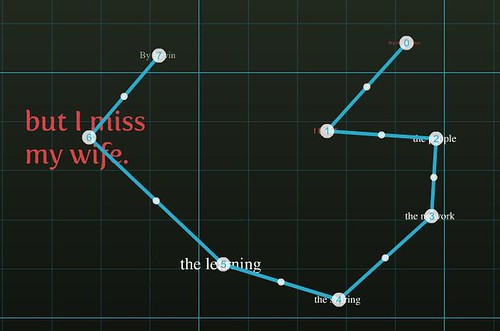
I have heard about Prezi from a few folks and even ventured to the site once or twice, but I could not wrap my head around it. You know how it is: you have a concept of something (ie, presentations use powerpoint, which are a formal sequence of slides moving forward) and it is difficult to shake loose. Just imagine when we are old and senile!
But here in Philly, I noticed a few people using Prezi and I thought: what the heck is that! And, that spurred me to want to spend a bit more time figuring it out. So I did.
Prezi is a free presentation tool (you can upgrade for a free) that shifts away from slides and moves content onto a large virtual canvas, where you layer in text and images and other media and then create a path through the material. The picture I am including here is a simple Prezi I did for my Day in a Sentence, showing the grid and the paths between my words. You can choose different themes, although the choices are limited (I wonder if more choices come when you pay for an upgraded account?).
Once I “got it,” I became hooked, and I decided that since life is all about learning and trying new things, I would delve right in. So, I took my somewhat-boring (I can admit it) powerpoint of a presentation I am giving on Saturday at NCTE around assigning and assessing digital work by students (ie, my digital science picture book project) and created a Prezi of it instead. And I will use that on Saturday and hopefully, I’ll weave this adventure into that talk, too.
What if there is no internet connection, you ask? Good question. Prezi allows you to download a copy as a flash file and share your presentation that way. You can also embed your prezi in blogs. Here is my Day in a Sentence (which is hosted this week over at Lynn’s blog — Reduction Physics — so come join us).
My larger question: How could students use this format to create a different kind of narrative, never mind a presentation. What would it mean to be shifting through a story over a large canvas of information? How would you plan that out and then do it? (if you have examples of students doing this, please share).
Peace (in the presentation),
Kevin